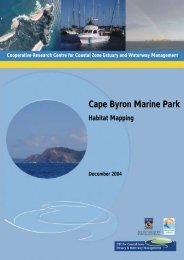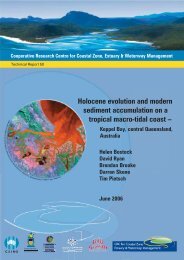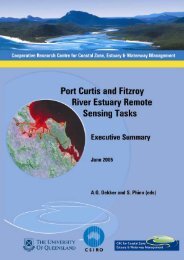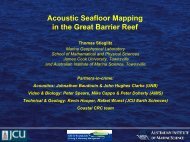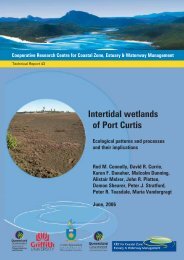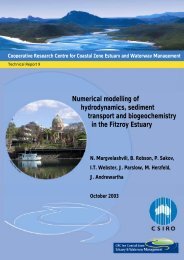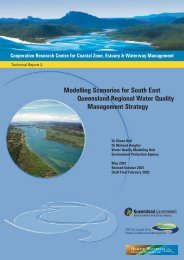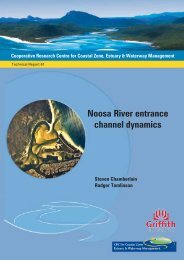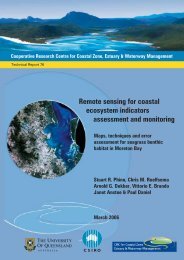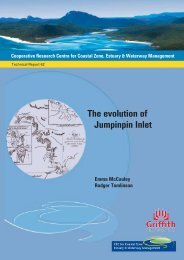Contaminant pathways in Port Curtis: Final report - OzCoasts
Contaminant pathways in Port Curtis: Final report - OzCoasts
Contaminant pathways in Port Curtis: Final report - OzCoasts
Create successful ePaper yourself
Turn your PDF publications into a flip-book with our unique Google optimized e-Paper software.
<strong>Contam<strong>in</strong>ant</strong> <strong>pathways</strong> <strong>in</strong> <strong>Port</strong> <strong>Curtis</strong>: F<strong>in</strong>al <strong>report</strong>2: Dissolved trace metals3. Survey<strong>in</strong>g of the Fitzroy River to above Rockhampton <strong>in</strong>dicated that this majorriver is a source of dissolved metals to the local coastal region. In particular,the Fitzroy conta<strong>in</strong>s elevated nickel concentrations which are consistent withsediment studies conducted by the Coastal Zone CRC. Under some flowconditions, the Fitzroy plume may enter The Narrows region and potentiallysupply dissolved metals to <strong>Port</strong> <strong>Curtis</strong>.4. There were no conspicuous sources of trace metal with<strong>in</strong> <strong>Port</strong> <strong>Curtis</strong>. Metals<strong>in</strong> suspended and benthic sediments are low and are not a likely source oftrace metals to the water column. The trace metal distributions <strong>in</strong> <strong>Port</strong> <strong>Curtis</strong>are likely to reflect a mixture of metal <strong>in</strong>puts <strong>in</strong>clud<strong>in</strong>g <strong>in</strong>dustrial discharges,mobilisation of metals from mangrove regions <strong>in</strong> The Narrows and the FitzroyRiver plume. Deconvolut<strong>in</strong>g these multiple sources is difficult. Modell<strong>in</strong>g ofcontam<strong>in</strong>ant <strong>in</strong>puts us<strong>in</strong>g a version of the <strong>Port</strong> <strong>Curtis</strong> hydrodynamic modelmodified to <strong>in</strong>clude <strong>in</strong>puts from the Fitzroy and The Narrows is probably themost effective way of understand<strong>in</strong>g this complex issue.5. Sal<strong>in</strong>ity and pH gradients were observed <strong>in</strong> <strong>Port</strong> <strong>Curtis</strong>. Sal<strong>in</strong>ities tend to behigher <strong>in</strong> the north of <strong>Port</strong> <strong>Curtis</strong> than <strong>in</strong> the surround<strong>in</strong>g coastal waters. Thiscould reflect evaporation losses <strong>in</strong> these more sheltered areas where watercirculation is restricted. Water column pH was lowest <strong>in</strong> The Narrows regionsand is most likely related to acid <strong>in</strong>puts from the adjacent mangrove regions.6. Particulate metals data <strong>in</strong>dicated that desorption of metals from suspendedsediments is unlikely to be a major source of dissolved trace metals. Theconcentrations of copper and z<strong>in</strong>c <strong>in</strong> suspended sediments were, <strong>in</strong> mostparts, typical of the benthic sediments and did not <strong>in</strong>dicate enrichment ofthese metals. Trace metal <strong>in</strong>puts to <strong>Port</strong> <strong>Curtis</strong> which contribute to theobserved dissolved metal concentrations are most likely to be delivered <strong>in</strong>solution form.19




